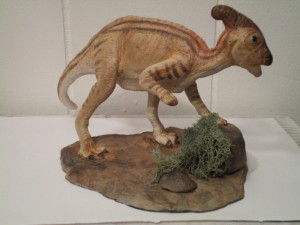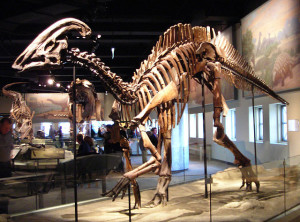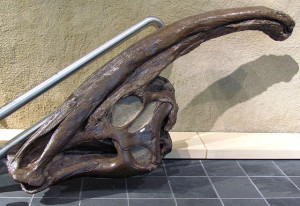Updated on: 04/04/2022
Parasaurolophus is an extinct genus of ornithopod dinosaur that roamed Northern America around 76.5–73 million years ago, during the Late Cretaceous Period. This genus is known from three species – Parasaurolophus walker (type species), Parasaurolophus tubicen, and Parasaurolophus cyrtocristatus. The appearance of these three species has slight difference from each other.
| Kingdom: | Animalia |
| Phylum: | Chordata |
| Clade: | Dinosauria |
| Order: | Ornithischia |
| Suborder: | Ornithopoda |
| Family: | Hadrosauridae |
| Tribe: | Parasaurolophini |
| Genus: | Parasaurolophus |
| Name Meaning: | Near crested lizard |
| Nickname: | Duck-billed dinosaur |
| Pronunciation: | par-ah-sawr-ol-uh-fus |
| Geological Time Period: | Late Cretaceous era |
| Size: | Length – 31 ft; Height – 8 ft (at the hips) |
| Skull Size: | 5ft 1 inch long |
| Crest size: | 6 ft long |
| Weight: | 5511 lbs |
| Diet: | Herbivore (especially land plants) |
| Birth Type: | Eggs |
| Running speed: | 21 to 25 mph |
| Closest relative: | Charonosaurus |

Parasaurolophus had a long and bulky body with a short, pointy and stiff tail. They had a duck-like beak with numerous cheek teeth. Their forelimbs were relatively short, but strong compared to other dinosaurs. One of their noticeable features was the long, narrow, backward-curving cranial crest (a crown like horn). Scientists said that the crest, made up of nasal bones, was hollow with different tubes leading to the tip of the crest. The tubes formation was simple in the type specimen. But, P. tubicen had a straight and long crest with a complex interior. There is no concrete evidence of sexual dimorphism. However, some suggested that males had bigger crests than females. There were several hypotheses regarding the uses of the cranial crest. Now scientists suggested that it had several functions, such as thermoregulation, sound amplification for communication and visual display. Some theories suggest that they had pebbly-textured skin.
The species of this genus dwelt in different habitats. They had both bipedal and quadrupedal locomotion. They probably lived in herd near shorelines and migrated to higher grounds during mating season. They ran/walked on two legs, but believed to have used four legs while foraging. They were relatively fast runners. It had a keen sight and hearing ability. They had no natural defense to protect themselves against enemies.

Skeleton samples and bone remains have been from New Mexico (Kirtland Formation) and Utah (Kaiparowits Formation), in the United States; and Alberta (Dinosaur Park Formation) in Canada. William Parks, a Canadian geologist and paleontologist, first described this genus in 1922 from a skull and partial bone remains found in Alberta by a University of Toronto field party in 1920. Parks named the type specimen in honor of Sir Byron Edmund Walker, former Chairman of Board of Trustees of the Royal Ontario Museum. The name Parasaurolophus has come from Greek words “para” (παρα), meaning ‘near’ or beside’; “saurus” (σαυρος), meaning ‘lizard’; and “lophos” (λοφος), meaning ‘crest.’
